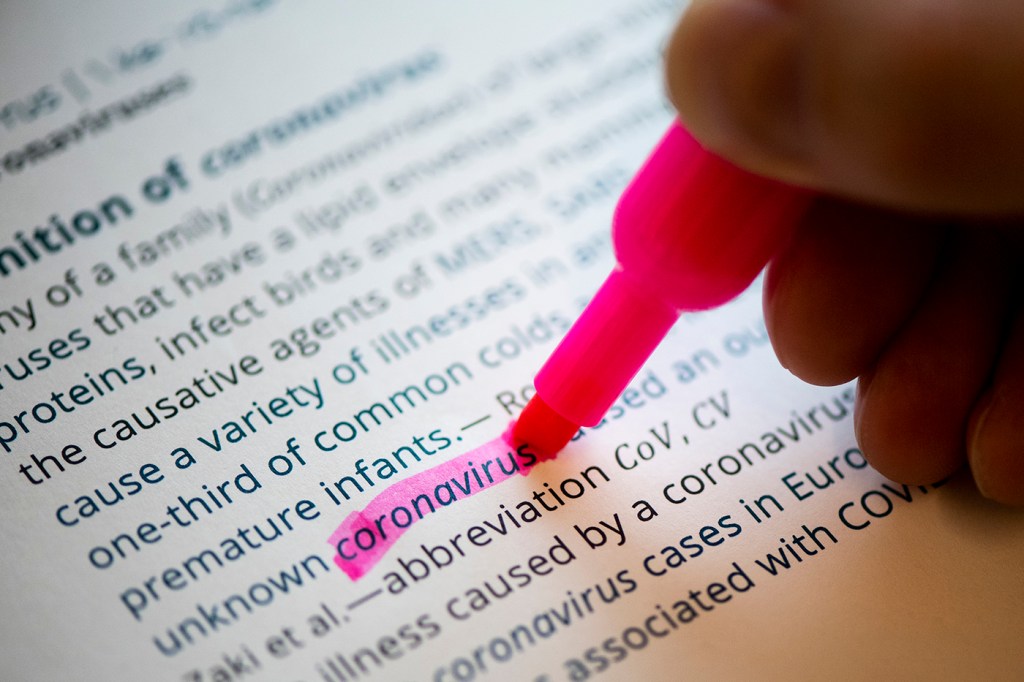What has changed in the way we talk about COVID-19? Revisiting pandemic terminology amid omicron.

As the SARS-CoV-2, the coronavirus that causes COVID-19, evolves, so too do the ways we talk about it.
That’s why it’s important to revisit some frequently used pandemic terms, not just to get a clearer sense of the situation at hand, but to better assess the potential dangers posed by the highly transmissible—but less deadly—omicron variant currently spreading across the country.
We asked Northeastern experts to flesh out some important distinctions in how we describe the data, what it means to be “exposed” to the coronavirus, and how widespread infections actually are at this stage of the pandemic. Here’s what they say.
What ‘exposure’ means, and what happens after
Federal officials have said in recent days that nearly everyone will be exposed to the omicron variant, given its unprecedented infectiousness. But being “exposed” is not the same as being infected. Exposure simply means that a person has come into contact with an infected person, says Robert Baginski, associate clinical professor and director of interdisciplinary affairs for the Department of Medical Sciences at Northeastern.

Portrait of Robert M. Baginski, director of interdisciplinary affairs and associate clinical professor. Photo by Matthew Modoono/Northeastern University
The CDC’s guidance on exposure has been the same since roughly the start of the pandemic. The federal agency defines exposure as having come into close contact—less than 6 feet—with an unmasked infected person for longer than 15 minutes.
If you’re exposed, “two things can happen—one being you don’t get the virus,” Baginski says. “Your chance of not getting the virus is much higher if you’re vaccinated, as we know.”
The alternative is that you do become infected. Many people who contract COVID-19 develop symptoms, but many—especially those who are vaccinated and boosted—do not.
“To be ‘infected’ means that the virus is actively replicating in a host,” Baginski says. “But that doesn’t necessarily mean you’ll experience symptoms. So, in a patient, the assumption that you’re not experiencing symptoms and therefore aren’t infected is wrong.”
If you’re vaccinated, not only are you less likely to fall ill, you are less likely to pass on the infection to someone else. That’s thanks to the vaccines’ ability to mitigate viral replication.
Of course, if you’re not fully vaccinated, your chances of getting sick and spreading the infection are, therefore, higher. Exactly how much higher is still an open question, Baginski says. That’s why, he says, it’s important that people continue to wear a mask, keep their distance, and get vaccinated.
Cases vs. infections: What are we missing?
The sheer scale of the omicron outbreak has underscored some of the longstanding problems in the available data and reporting methods upon which officials rely. One such problem is the underdetection of actual infections in official case counts.

Alessandro Vespignani, director of the Network Science Institute and Sternberg Family Distinguished University Professor of physics, computer sciences, and health science at Northeastern University. Photo by Matthew Modoono/Northeastern University
“The number of actual infections is likely amplified by a factor of five to ten, at least,” says Alessandro Vespignani, director of the Network Science Institute and Sternberg Family Distinguished Professor at Northeastern.
By COVID-19 infections, officials mean the total number of people in whom the virus is currently replicating. Cases, on the other hand, are the number of known positive COVID-19 test results, as collected by local health authorities and reported by the U.S. Centers for Disease Control. For a variety of reasons, countless infections are not represented in official case totals that are reported out each day; therefore, “infections” and “cases” are not interchangeable. Cases are a subset of total infections, the latter of which is unknowable.
With earlier, less-infectious variants, the discrepancy between reported cases and presumed infections was large, but probably not as wide as it is thought to be with omicron, Vespignani says.
One reason for that is that testing strategies are shifting. More people are relying on at-home tests to see if they have COVID-19, and not reporting their results to public health agencies.
While the CDC now recommends five days of isolation after testing positive, it does not require that results from at-home tests be reported to health authorities, according to its latest self-testing guidance. States like Massachusetts don’t have reporting mechanisms for residents with positive at-home test results in hand to use in alerting authorities—compounding the gap between official case counts and total infections.
Hospitalized ‘with’ or ‘for’ COVID-19?
Shifts back to in-person activities have been ushered in by analyses suggesting that omicron is less severe for fully vaccinated and boosted populations than previous variants. Still, record numbers of people are in the hospitals with COVID-19.
But those numbers might not reflect reality. In their count of hospitalized patients with COVID-19, hospitals also include patients who incidentally test positive for the virus while admitted for other, non-COVID-related reasons.
Many hospitals and public health officials are now working to redefine what constitutes a COVID-19 “hospitalization” to better account for those distinctions—between patients hospitalized “for” COVID-19 versus those “with” COVID-19 that happen to be hospitalized. States like Massachusetts have rolled out new guidance to reclassify hospitalizations accordingly, giving greater emphasis to those severely ill with the virus. The changes have shrunk totals in some hospitals by as much as 50%.
Despite the imperfections, the existing metrics—for hospital and testing reporting—are still useful in keeping pace with pandemic fluctuations more broadly, Vespignani says; but there’s always room for improving and refining methods to provide for more accurate surveillance.
“All data are important,” Vespignani says. “We can’t just discard the data. Cases might not be as important as before, but they are still an early indicator of how things are going.”
For media inquiries, please contact media@northeastern.edu.






